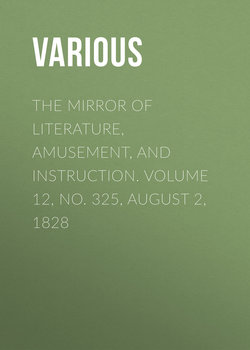Читать книгу The Mirror of Literature, Amusement, and Instruction. Volume 12, No. 325, August 2, 1828 - Various - Страница 1
Оглавление"Whoever walks through London streets,"
Said Momus to the son of Saturn,
"Each day new edifices meets,
Of queer proportion, queerer pattern:
If thou, O cloud-compelling god,
Wilt aid me with thy special grace,
I, too, will wield my motley hod,
And build a church in Langham-place."
"Agreed," the Thunderer cries; "go plant
Thine edifice, I care not how ill;
Take notice, earth. I hereby grant
Carte blanche of mortar, stone, and trowel.
Go Hermes, Hercules, and Mars,
Fraught with these bills on Henry Hase,
Drop with yon jester from the stars,
And build a church in Langham-place."
London Lyrics-New Monthly Mag.
Among all our specimens of contemporary church-building, none has excited more animadversion than All-Souls', Langham-place, erected in 1822-1825, from the designs of Mr. Nash. Its general effect is extraordinary and objectionable; but, unfortunately for what merit it really possesses, many of its assailants have so far disregarded the just principles of taste and criticism, as to go laboriously out of their way to be profanely witty on its defects. Song and satire, raillery and ridicule, pun and pasquinade, and even the coarseness of caricature, have thus been let off at this specimen of NASH-ional architecture; whilst their authors have wittingly kept out any redeeming graces which could be found in its architectural details.
The principal features of the exterior were suggested by its situation, it being placed on an angular plot of ground, between Langham-place and Regent-street. To afford an advantageous view from either point, the tower, which is circular, is nearly detached from the body of the church, and is surrounded by columns of the modern Ionic order, supporting an entablature, crowned by a balustrade, which is continued along the sides of the church. Above the portico is a Corinthian peristyle, the base of which is also that of a fluted cone, which forms the spire, and is terminated in an acute point. The steeple is complete in itself, and adapted to its situation, having the same appearance which ever way it is viewed. This portion of the edifice has, however, been more stigmatized than any other, although it has been pronounced by persons of taste and accredited judgment to be the best steeple recently erected. To our eye, the church itself, apart from the tower, (for such it almost is) is perhaps, one of the most miserable structures in the metropolis,—in its starved proportions more resembling a manufactory, or warehouse, than the impressive character of a church exterior; an effect to which the Londoner is not an entire stranger. Here, too, we are inclined to ascribe much of the ridicule, which the whole church has received, to its puny proportions and scantiness of decoration, which are far from being assisted by any stupendousness in their details, the first impression of which might probably have fixed the attention of the spectator. Indeed, the whole style of the tower and steeple appears peculiarly illadapted for so small a scale as has here been attempted.
As we love "a jest's prosperity," we recommend such of our readers as are partial to innocent pasquinade, to turn to the "Lyric," in a recent volume of the New Monthly Magazine, commencing as above. It is too long for entire insertion here, but its raciness will doubtless gratify those who may be induced to refer to it.
